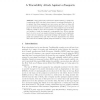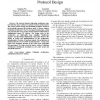250 search results - page 38 / 50 » More on the Security of Linear RFID Authentication Protocols |
74
Voted
COMCOM
2000
14 years 11 months ago
2000
In this paper, we describe a thread of research which we have followed off and on at Cambridge for about three years. Our topic is the security of electronic documents, in the bro...
FC
2010
Springer
15 years 3 months ago
2010
Springer
Since 2004, many nations have started issuing “e-passports” containing an RFID tag that, when powered, broadcasts information. It is claimed that these passports are more secur...
ICNP
2007
IEEE
15 years 6 months ago
2007
IEEE
The current Internet addressing architecture does not verify the source address of a packet received and forwarded. This causes serious security and accounting problems. Based on t...
112
Voted
ICISC
2007
15 years 1 months ago
2007
In Ubiquitous Computing Environment (UCE), service provider wants to provide its service to only legitimate users. Some users who belong to same service provider do not want to rev...
CRYPTO
2006
Springer
15 years 3 months ago
2006
Springer
Abstract. We study unconditionally secure 1-out-of-2 Oblivious Transfer (1-2 OT). We first point out that a standard security requirement for 1-2 OT of bits, namely that the receiv...


